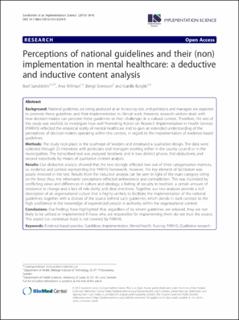| dc.contributor.author | Sandström, B. | |
| dc.contributor.author | Willman, A. | |
| dc.contributor.author | Svensson, B. | |
| dc.contributor.author | Borglin, G. | |
| dc.date.accessioned | 2023-03-20T11:24:26Z | |
| dc.date.available | 2023-03-20T11:24:26Z | |
| dc.date.issued | 2015 | |
| dc.identifier.citation | Sandström, B., Willman, A., Svensson, B. & Borglin, G. (2015). Perceptions of national guidelines and their (non) implementation in mental healthcare: a deductive and inductive content analysis. Implementation Science, 10(1), 1-13. | en_US |
| dc.identifier.uri | https://hdl.handle.net/11250/3059215 | |
| dc.description.abstract | Background
National guidelines are being produced at an increasing rate, and politicians and managers are expected to promote these guidelines and their implementation in clinical work. However, research seldom deals with how decision-makers can perceive these guidelines or their challenges in a cultural context. Therefore, the aim of this study was twofold: to investigate how well Promoting Action on Research Implementation in Health Services (PARIHS) reflected the empirical reality of mental healthcare and to gain an extended understanding of the perceptions of decision-makers operating within this context, in regard to the implementation of evidence-based guidelines.
Methods
The study took place in the southeast of Sweden and employed a qualitative design. The data were collected through 23 interviews with politicians and managers working either in the county council or in the municipalities. The transcribed text was analysed iteratively and in two distinct phases, first deductively and second inductively by means of qualitative content analysis.
Results
Our deductive analysis showed that the text strongly reflected two out of three categorisation matrices, i.e. evidence and context representing the PARIHS framework. However, the key element of facilitation was poorly mirrored in the text. Results from the inductive analysis can be seen in light of the main category sitting on the fence; thus, the informants’ perceptions reflected ambivalence and contradiction. This was illustrated by conflicting views and differences in culture and ideology, a feeling of security in tradition, a certain amount of resistance to change and a lack of role clarity and clear directions. Together, our two analyses provide a rich description of an organisational culture that is highly unlikely to facilitate the implementation of the national guidelines, together with a distrust of the source behind such guidelines, which stands in stark contrast to the high confidence in the knowledge of experienced people in authority within the organisational context.
Conclusions
Our findings have highlighted that, regardless of by whom guidelines are released, they are not likely to be utilised or implemented if those who are responsible for implementing them do not trust the source. This aspect (i.e. contextual trust) is not covered by PARIHS. | en_US |
| dc.publisher | Implementation Science | en_US |
| dc.rights | Navngivelse 4.0 Internasjonal | * |
| dc.rights.uri | http://creativecommons.org/licenses/by/4.0/deed.no | * |
| dc.subject | evidence-based practice | en_US |
| dc.subject | guidelines | en_US |
| dc.subject | Implementation | en_US |
| dc.subject | mental health | en_US |
| dc.subject | nursing | en_US |
| dc.subject | PARIHS | en_US |
| dc.subject | qualitative research | en_US |
| dc.subject | retningslinjer | en_US |
| dc.subject | veiledere | en_US |
| dc.subject | implementering | en_US |
| dc.title | Perceptions of national guidelines and their (non) implementation in mental healthcare: a deductive and inductive content analysis | en_US |
| dc.type | Journal article | en_US |
| dc.source.pagenumber | 1-13 | en_US |
| dc.source.volume | 10 | en_US |
| dc.source.journal | Implementation Science | en_US |
| dc.source.issue | 1 | en_US |
| dc.identifier.doi | https://doi.org/10.1186/s13012-015-0234-0 | |

